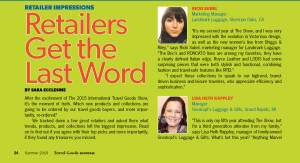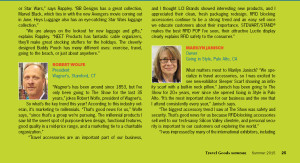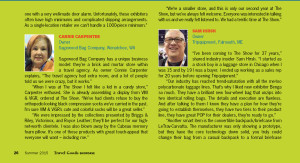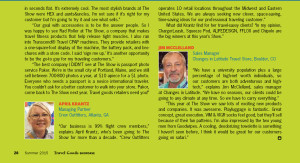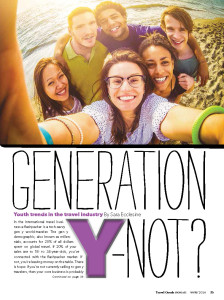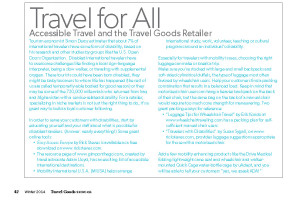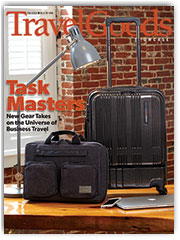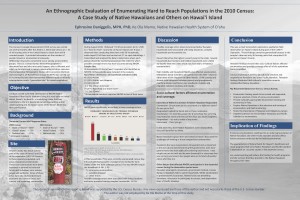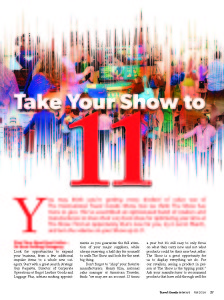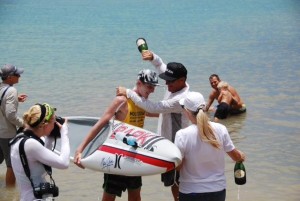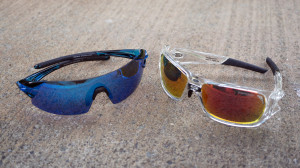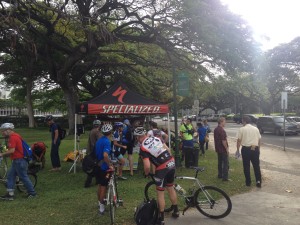This article originally appeared in Travel Goods Showcase.
Retailers Get the Last Word
Generation Y-Not?
Youth Trends in the Travel Goods Industry
In the international travel business a flashpacker is a tech-savvy gen y world-traveler. The gen y demographic, also known as millennials, accounts for 20% of all dollars spent on global travel. If 20% of your sales are to 18- to 34-year-olds, you’ve connected with the flashpacker market. If not, you’re leaving money on the table. There is hope: if you’re not currently selling to gen y travelers, then your core business is probably their boomer parents. Show boomers that you have luggage they can buy for their gen y kids for trips or graduation presents, and introduce their flashpacker offspring to your store.
Who Are the Flashpackers?
FLASHPACKERS ARE VERY DIFFERENT from the penniless, frame-pack toting, Eurail-riding young people of previous generations. ITB-Berlin’s World Travel Trends Report 2014 acknowledges “youth travel was long seen as a small part of the travel and tourism industry,characterized by cheap prices and low spending. However, the picture has changed in recent years, according to diverse studies.” ITB-Berlin reports that“the World Tourism Organization estimates that youth travel generated $182billion (U.S.) in international tourism receipts in 2012…more than 20%.”Globally, fewer than half (45%) of18- to 34-year-old travelers are on vacation. Young globetrotters are instead abroad for educational purposes and volunteer work (43%) and 15% are business travelers. Among U.S. citizens,almost half (49%) of work travel is done by gen y and gen xers: 25% are 18 to34 and 24% are 35 to 44 (Travel Facts and Statistics, U.S. Travel Association). Peter Cobb, co-founder of eBags.com, expands on the customer behind these statistics. “Millennials have a different value scale when it comes to work and life experience. They’re not as interested in making a fortune, they want to get out and experience the world. They’ll work for six months and then head to Costa Rica for three months with one backpack.” Many jobs available to millennials (whether traditional entry-level or knowledge-based jobs like computer programming) don’t penalize this type of fractured resumé. In the past 10 years youth travel destinations have become much more global. Europe has decreased slightly in popularity, while gen y travel to the Americas, Asia and Africa has surged over the last decade (ITB-Berlin’s World Travel Trends Report 2014).
Are you gen y-ready?
YOU MAY NEED TO UPDATE YOUR retail assortment with fashion-forward styles that appeal to younger consumers.Backpacks are beginning to replace the classic messenger bag as the personal item that gen y travelers bring on a flight. Make sure your personal item stock reflects the shrinking size of tablets and laptops. Gen y travelers have the latest electronic gear, and they don’t want or need a big bag for their tiny tablet.A personal item could also be a camera bag. Photography is a common passion for gen y travelers, but they don’t want to carry expensive equipment for their hobby in something that screams“camera bag” (a legitimate security concern). Dan Maravilla, co-founder of HEX, shared a bag designed to address this problem: the HEX Camera Gear Bag. The Camera Gear Bag sits upright and can be worn as a backpack. It holds camera or DJ gear with a separate storage compartment for up to a 15”Mac Book Pro and front iPad pocket. Millennials often reject traditional luggage for international travel. No one wants to lug a rollerboard up three flights of stairs from the Paris Metro. Cobb’s experience is that “we sell huge numbers of a backpack called the TLS Weekender, not as a ‘personal item’ but as the carry-on bag and sole piece of luggage that is going to get efficient packers through two to three weeks in Spain. The TLS Weekender looks like a backpack but zips open and lays flat like a suitcase.” Cobb’s must-have list for an international travel backpack:it’s designed to work with packing cubes (which add organization and compression) while being small enough to fit tight international luggage requirements,and squishable enough to shove into the limited carry-on space available on small regional jets. When you’re picking backpacks for millennials, look for neutrals that aren’t black: the on-trend patterns featured in HEX’s Division,Hayward, and Westmore Collections will read as match-anything neutrals while standing out from a sea of black bags. Square backpacks (rectangular shaped,sometimes roll-top, and often made of waterproof fabrications like tarpaulin and waxed cotton) are the most fashion-forward of today’s travel backpacks. Many are large enough that they can be used in place of rollerboard luggage for multi-day trips, especially to foreign destinations with cobblestones.For those looking for a rollerboard with younger styling, HEX will be adding rollerboards to their collection, which they’ll be showing at The International Travel Goods Show in March 2015 and then shipping in fall 2015. Another high-style bag company to look for in the rollerboard category is EPIC Travelgear, based in Sweden but shipping from Seattle to the North American market from newly formed EPIC Travelgear USA by the time this issue goes to print. CEO James Krueger explains his company’s philosophy: “The gen y customer wants to be on-trend but also look different from everyone else. That’s not easy to design for while maintaining our unique EPIC Travelgear visual identity.” EPIC Travelgear’s solution to this design dilemma is something Krueger calls “managed madness.” Krueger explains “take a little bit of risk, maybe 10%. And within that 10% really go crazy. If it doesn’t sell, just let it go. Close it out, move on. That kind of philosophy is where some of our wildly successful product ideas like our Kiss Signature Series come from.” Krueger recommends following the managed madness philosophy across the supply chain, including retail buying. In Sweden, EPIC Travelgear’s best managed madness resources is LuggageLAB, which is both a storefront and a creativity lab for testing new ideas and then showing them to consumers (both in person and through social media). EPIC Travelgear has in-house production capability at LuggageLAB called CustomChromatix™. CustomChromatix™ allows EPIC Travelgear’s LuggageLAB to produce very small runs of luggage with hard-wearing personalized decals, painted graphics inside or out, and custom components for some models. Krueger describes the process: “You send us your jpeg, and within days we’ve printed your graphic with spray paint vinyl on your new custom luggage collection.” With CustomChromatix™, your gen y customers’ desire to have something different becomes a retail opportunity, not a liability. Career-oriented millennials do exist and they travel more for work than boomers. Companies tend to send their young, single employees out on the road, and flashpackers welcome the adventure. They may have to fly to a different city during the week to work and then fly home for the weekend. Road warriors want to leave their hands free as they walk through the airport so they can check email on their smartphones, so a significant number are choosing backpacks over rollerboards. Young business travelers asked eBags for a Weekender with a more polished look, which became the TLS Professional Weekender. It’s built with additional tech features, like a TSA friendly laptop compartment and an external adaptor garage. An important distinction between gen y and traditional business travelers is the degree of energy and exploration they bring to their business travel. When millennials travel for work they bounce around and explore, deliberately extending their work trip over a weekend. A lot of that spontaneous travel becomes less desirable after getting married and starting a family. This is one of the reasons the gen y business traveler is also attracted to stylish weekender-sized duffles like the Overnight Travel Bag by HEX. Duffles and backpacks have the advantage of camouflage: if you are between hotel check-ins, out exploring in your down time, you don’t look like a tourist.
Does your store experience (both brick and mortar and online) match the millennial market?
ADDING ON-TREND MERCHANDISE won’t help your sales if gen y customers walk right past your store or click away from your website. Updating the look of your brick and mortar and online storefront will be appreciated by your gen x and boomer customers as well as your gen y customer. Gen y, gen x and boomer travelers are all influenced by style and trend, enjoy researching purchases and/or buying online, and want both the best price and the best service. The differences are in degree. Gen xers and gen ys have a very similar aesthetic sensibility, but gen xers have a nostalgic enjoyment of mall shopping that was never developed in the gen y consumer. While some boomer customers love to be on-trend, as a group they tend to be tolerant of or appreciate traditional, rather than fashion-forward, design. So the boomer and gen x customer will come see you despite a dated façade and a classic rather than fashion-forward product mix, but gen y won’t. Ask for help: many manufacturers including HEX provide fixtures and POP to their customers, and some will customize them to match the visual identity of your retail space. For example, HEX recently powder coated fixtures black to match the existing look of BrandsWalk in Orange County. Plan your layout so your gen y merchandise is front and center to let flashpackers know you have something for them from the minute they walk in the door. And whether you sell primarily in person or online, you won’t be able to beat the pricing and selection on Amazon, but you can you set yourself apart through customer service and shopping experience. Maravilla explains one tactic they use on their small e-commerce website: “every bag goes out with a handwritten note on Letterpress paper in a black envelope sealed with a logoed sticker.” Is there similar level of retail theater you can deploy that complements your store and sets you apart?
Does your online presence represent the best you?
NO, WE’RE NOT TALKING ABOUT match.com, we’re talking about whether your website and social media interactions draw millennials in, or turn them away. If you’re not sure, get an outside opinion of whether you need to update the cosmetic look of your website. Everyone can benefit by adding more useful content such as travel information and packing videos. Cobb puts it this way: “millennials are nearly hard-wired to shop on the internet. They enjoy online research to find a product that fits their specific needs at the lowest possible price, it’s like playing a video game for them. I can’t tell you how many times my kids have taken my phone out of my hand and said ‘Dad, let me find that for you. Let me get you the best price.’ Going to a mall to shop, that’s not their idea of fun. They are time starved, shopping online from their phone is one of their lifehacks.” Whether or not you sell online, make sure your website is content-rich in order to engage the treasure-hunting millennial and get them in your physical storefront. Set high standards for your website: “We work hard to make our online communications compelling and informative, we’re proud of the fact that many of our instructional videos average three and a half minutes of viewing time,” explained Cobb.
Start the conversation: enlist help to enhance your presence on social media
ENGAGE MILLENNIALS BY USING the right platform: concentrate on Instagram, with a smaller emphasis on Facebook, Twitter and Pinterest. You can use a free service like Hootsuite to pre-stage your social media communication across multiple platforms to push content out over a day or a week. Post images that tell a story or are educational, like a great packing tip or a favorite place to eat in Paris. Deemphasize product shots, unless they are extremely editorial, such as a bag with a wow graphic or feature. Carefully chosen friends and customers can “guest host” your social media account while they are traveling (this works best for Instagram). Krueger explains the EPIC Travelgear philosophy: “We view our company as a way to connect with people. The medium happens to be luggage, but that’s just a vehicle to share stories and communicate our point of view.” This carries over to the EPIC Travelgear social media strategy: “we’re in touch with the gen y traveler through Instagram, Facebook and Twitter. If you engage with your customer on social media be ready to listen as well as talk. Be humble. Take feedback, fix problems. Don’t greenwash. If you aren’t authentic the gen y customer will call you out in a public way. But if you are real, if you focus on fun, they will embrace your brand.” Social media is also a key part of eBags’ marketing strategy. In Cobb’s experience “because of the millennials’ addiction to technology they’re relatively easy to engage if you create content that is up to their standards. When we have our handbag-a-day or backpack-a-day sweepstakes on Facebook, the most youth-oriented bags get the most likes and shares.” Jenn Simon from Sea to Summit has also found that “gen yers love any online contest or giveaway. They also are attracted to engaging promotions that involve photos and videos.” Coming up with interesting content is one of the challenges of having a social media presence. Krueger’s advice: “being involved with our local community is one of our values, and also a great way to generate social media content. We sponsor professional cycling teams, they’re an ideal billboard and testing ground for a travel company.” For manufacturers social media is also a key part of the product development process. Cobb shares that “we use social media not only for marketing but also product feedback and development ideas, which we combine with the reviews on our website to inform warranty, R&D and purchasing decisions. All of the thumbs-down reviews go to a group within the company, are passed along to customer service to make right, are compiled and given to our brand partners, and inform our in-house product development.” Two examples of luggage developed out of eBags’ social media feedback process are the aforementioned TLS Professional Weekender, and the TLS Mother Lode Weekender Junior, which was designed for people with a smaller frame and shorter torso. Retailers can comb through their online interactions to inform future buying decisions and respond to unhappy customers. Just make sure you have a staffing plan in place to reply to customer service queries that come in through social media.
Millennials and the future of the travel industry
IN INDUSTRIES SUCH AS YOGA, Skate, Surf, and Bike Messenger/Urban Cyclist there was a moment where the products associated with the activity became an everyday fashion statement. Yoga pants went to the coffee shop, surf trunks were worn to school in Kansas, university students rode fixed gear bikes to class, backpacking clothing became walking-around-Seattle clothing and businessmen took their lunch to work in messenger bags. This is also the moment when people in those industries went from making a little money to making huge amounts of money. And in the same way, a luggage store could become a Travel Lifestyle store. All of these examples have a demographic in common: they were created by style conscious gen x consumers. The gen y customer is now driving retail sales, with the same potential impact in the industries most closely associated with a millennial’s sense of self. Travel consumers are universally proud of their status as world citizens. If you invest in merchandise your customers can buy and use year round, not just on trips, you give them the opportunity for (what a sociologist would call) enforcing self-concept through product symbolism. In English, that means they’ll wear a stylish travel wrap at the office and explain that they bought it for their last transatlantic flight. When they pull out their RFID blocking wallet they can tell the guys they need it for jaunts around Asia. And they can visit you between trips to buy more lifestyle items that they hope to use for travel…someday.
This article originally appeared in the Winter issue of Travel Goods Showcase.
Travel for All
Accessible Travel and the Travel Goods Retailer
Tourism economist Simon Darcy estimates that about 7% of international travelers have some form of disability, based on
his research and other studies by groups like the U.S. Open
Doors Organization. Disabled international travelers have
to overcome challenges like finding a local sign-language
interpreter, being a slow walker, or traveling with supplemental
oxygen. These tourists could have been born disabled, they
might be baby boomers to whom life has happened (the rest of
us are called temporarily-able bodied for good reason) or they
may be some of the 720,000 millennials who returned from Iraq
and Afghanistan with a service-related disability. For a retailer,
specializing in niche markets is not just the right thing to do, it’s a
great way to build a loyal customer following.
In order to serve your customers with disabilities, start by
educating yourself and your staff about what is possible for
disabled travelers. (Answer: nearly everything!) Some great
online tools:
• Easy Access Europe by Rick Steves is available as a free
download on www.ricksteves.com.
• The resource page of www.gimponthego.com, created by
travel advocate Adam Lloyd, has an exciting list of accessible
international destinations.
• Mobility International U.S.A. (MIUSA) helps arrange
international study, work, volunteer, teaching or cultural
programs around an individual’s disability.
Especially for travelers with mobility issues, choosing the right
luggage can make or break a trip.
Make sure you’re stocked with large and small backpacks and
soft-sided cylindrical duffels, the type of luggage most often
favored by wheelchair users. Help your customers find a packing
combination that results in a balanced load. Keep in mind that
motorized chair users can hang a heavier backpack on the back
of their chair, but the same bag on the back of a manual chair
would require too much core strength for maneuvering. Two
great packing essays for reference:
• “Luggage Tips for Wheelchair Travel” by Erik Kondo at
www.wheelchairtraveling.com has a packing plan for self sufficient manual chair users.
• “Travelers with Disabilities” by Susan Sygall, on www.ricksteves.com, provides luggage suggestions appropriate
for those with a motorized chair.
Add a few mobility enhancing products like the Drive Medical
folding lightweight cane seat and wheelchair and walker mounted
Quick Cage water-bottle cage by uAdapt, and you will be able to tell your customers “yes, we speak ADA!”
This article originally appeared in the Winter issue of Travel Goods Showcase.
Luggage Obsessed
Good news bad news: I edited my first magazine, the business issue of Travel Goods Showcase. And now I’m obsessed with luggage and travel accessories, and all I want to do is jump on a plane to somewhere fabulous.
Check out travel trends and new travel products at the Travel Goods Association website.
The Difficulties of Counting Native Hawaiians in the U.S. Census
My brilliant friend, anthropologist Ephrosine Daniggelis, was accepted for a poster paper at the prestigious He Huliau Health Disparities Conference.
I’m proud to have created a four foot by six foot poster version of her paper for her. It was an interesting graphic design challenge and I learned a lot about the socio-cultural factors that affect enumeration and coverage.
Take Your Show to 11
Take Your Show to Eleven
You may think you’re getting every decibel of value out of The Show, but we think The Show has more to give. We’ve assembled an opinionated band of retailers and manufacturers to share their very best ideas for optimizing your time at The Show. Find an opportunity that’s new for you, try it out in March, and turn the volume on your Show up to eleven.
Find Your Next Best Seller…Or Best Selling Category
Look for opportunities to expand your business, from a few additional impulse items to a whole new category. Start with a great search strategy. Guy Paquette, Director of Corporate Operations at Bagot Leather Goods and Luggage Plus, advises making appointments so you guarantee the full attention of your major suppliers, while always reserving a half day for yourself to walk The Show and look for the next big thing.
Don’t forgot to “shop” your favorite manufacturers. Henry Kim, National Sales Manager at American Traveler, finds “we may see an account 12 times a year but it’s still easy to only focus on what they carry now and not what products could be their new best seller. The Show is a great opportunity for us to display everything we do. For our retailers, seeing a product in person at The Show is the tipping point.” Ask your manufacturer to recommend products that have sold-through well for the retailers that have picked them up, but are not yet widely available. A great example is the National Geographic collection from Travelpro, utilizing National Geographic’s extensive library of images. “We use these great images on kid’s luggage, insulated lunch totes, mega totes and in other interesting ways. We have sold these products very effectively with a couple of large retailers,” enthused Scott Applebee, VP of Marketing at Travelpro. “We would like to see other retailers broaden their offering to carry these products. I think they would be very successful.”
Canadian retailers have a secret weapon: handbags. In Canada handbags are traditionally sold in luggage stores. They retail for as much as a piece of luggage, have better margins, take up a fraction of the footprint, and women buy at least one a year. Fashion bags have as many as five seasons a year, freshening the look of the store, and retailers receive a closeout allowance.
If you don’t have the advantage of doing business in Canada you can still move into this lucrative category. You’ll need to commit: offer a selection of brands, research color and style trends, and advertise your new product mix. But the upside is huge. If you want to learn more, noteworthy handbag manufacturers such as Osgoode Marley attend The Show, and suppliers like Boconi also produce beautiful women’s clutches, totes and cross-body bags. Or just find a Canadian and ask them for the inside scoop. That’s what we did. After learning that Paquette wrote a handbag-buying article for the Mode Accessories show, we interviewed him for this piece.
Accessories are the secret to sales growth for many retailers, and like your golf swing, they are something you can always improve. Small personal goods that retail under $40 are a lucrative category with great margins, fast turns and no consumer price-checking. During a luggage purchase “a good rule for your salesperson is sell 10% of the value of luggage in accessories” enthuses Paquette. “I tell them ‘that pays your salary.’ They’ve really gotten the idea. We suggest items like an RFID protection package and luggage locks, money belts, etc.” Paquette recommends accessory suppliers like Lewis N. Clark and Travelon. If you need help keeping on top of all your accessory SKUs, in Canada you can hire Counter Intelligence to take inventory and create fill-in orders.
Don’t forget about leather goods like a wallet or card case, which give consumers a chance to shop for pleasure and buy a small luxury in between the investment purchases of a good suitcase or briefcase. Boconi supplies retailers with a leather wrapped tray to display wallets next to the cash register. “So many men are carrying around ancient and decrepit wallets” explains Bobby Williams, president of Boconi. “When your customer pulls out their broken-down wallet to pay, point out your assortment of trade-up and technical (RFID) wallets on the front counter.”
Colleen Coe, Manager and Buyer at AAA Oregon/Idaho Travel Stores, tiptoed into travel clothing in 2009 and never looked back. “Westarted with UbU jackets. This category did well so in 2011 we brought in a travel vest from SCOTTeVEST. In 2013 we added a travel blazer from Flair Expressions and it has really taken off for us. We don’t have a dressing room so we stick to outerwear & vests. Women are the primary shoppers in this category and they see the value of a stylish, easy-care travel garment.”
And finally, it’s important to remember that you don’t need to bring in a new product assortment to have a new product assortment. Bobby Williams advises: “Carry messenger-style laptop bags? Display them on a waterfall, then on a mannequin, then fanned out on a table. Changing the look of your displays every few weeks allows your customer to discover the merchandise you already have as if it’s brand new.”
Maximize Your Impact
You’re not just searching for inspiration at The Show, you’re bringing inspiration to The Show. Make sure to pack all those brilliant product ideas, sales data, and warranty records. You may be buying for 2015, but it’s time to be thinking about 2016. Here’s how to ask for the product changes you want–and be heard.
First, it’s important to understand the development cycle. In order to cover up-front costs like design, sampling and tooling, most manufacturers need to get at least two years out of a new item. So it may not be possible for a company to take the corrective action you recommend in the first year of a product. But that doesn’t mean they’re not listening. “Once you launch a new line and place the large initial order with the factories, you have already invested quite heavily. Given this, our goal is to try to get retailer and consumer feedback early on in the development process” Scott Applebee explains. “We always have some new products that are in the design phase and we actively seek input from our retailers at The Show, and make changes to these early stage products based on this feedback. We always bring our design and development team to The Show to better understand reaction to our products.”
Expect that the capabilities of each company are different. “Not everyone realizes that American Traveler is very flexible, both in our design/manufacturing resources and our company culture” explains Henry Kim. “It never hurts to ask. We produce a diverse collection of brands, so what you need may already exist in one of our other collections. And if not we want to hear your idea. Product development is much easier if it’s a two-way street. We see progress as incremental, with each new idea opening up a new opportunity.”
Guy Paquette’s strategy to be heard by his manufacturers is a one-two punch of sales…and relationships. “While manufacturers do pay more attention to the product suggestions of their largest volume customers, developing a friendship and keeping in touch goes a long way too.” He wants other retailers to know that it’s possible to get your ideas into production if you are realistic and persistent. “We go to the Samsonite Partnership Conference. I’d been requesting bright yellow and orange suitcases. They wheel out this luggage and announce ‘Guy’s luggage is here!’ We sold through those bags so well we repeated our order several times in the first six months. It’s a great feeling when you know they’re listening.”
Colleen Coe needed a tote with specific features at a certain price point. It took persistence to convince a manufacturer to make it, but when they did it was a big seller and many of their other customers picked it up. “It’s a great feeling when a manufacturer takes your advice. It makes you really feel like you have a stake in the success of the brand.”
Another area where teamwork and communication is essential is when products break. Warranty issues are frustrating because of the nature of retail. When a wheel falls off in the middle of a 3-week trip to Europe, it’s the store manager who has to have an uncomfortable conversation with the consumer, not the designer. Coe explains “it’s good when I hear ‘ok, I’ll send this in to the QC people’ and even better (and much rarer) when you hear back when the problem has been addressed. Give us that extra assurance that you’re learning from the problem.” If you’re not sure that your warranty problems are being heard, bring them up privately at The Show during your scheduled meeting. Make sure to bring warranty reports and photos that show the scope of the problem. Although you may have moments when you believe “that a manufacturer has clearly never used a product before building thousands of them,” as David Stoller, President of Suitcases and More, explained to me in frustration, don’t stop sharing your observations. Bobby Williams acknowledges “some designers don’t want to hear about any changes. My ego’s not in it. I want your ideas and your feedback. All of us working together, that’s what makes this fun.”
Make it Work for You
Manufacturers often have Show programs that can gain you serious margin points on new luggage lines and closeouts. But the programs can be confusing and the terms/payment schedule may not work for your selling season, shipping or tariff costs. If you don’t already belong to a buying group that has pre-negotiated a program, get ready to discuss your buying plan for each vendor and negotiate terms at The Show.
Pre-show, get in a huddle with your bookkeeper, buyer and manager and come up with a cash-flow plan for next year. Then if you are offered 5% 30 net 60 and you need an extra month to pay–or can pay early–negotiate that extra month or discount face to face with the decision maker, not after the fact with the guy two levels below the decision maker.
Don’t forget about shipping, especially if you are on the other side of the country, or the world, from your manufacturer’s warehouse. David Stoller notes “required volume for shipping discounts is just as important as early payment discounts.” It’s possible to negotiate differences for special circumstances, such as higher tariffs and prohibitive shipping costs to your country. “I already have a non-profit” jokes Guy Paquette. “This is a business. You have to develop mutually beneficial relationships, you must be willing to give as much as you take.”
There’s strength in numbers: get involved with the organization specific to your country and work with manufacturers as a group. If one doesn’t exist, do what Guy Paquette did and form your own. (Canadian Luggage & Leathergoods Dealers Association (CLLDA), somewhat like the NLDA in the U.S.)
Remember that as the manufacturer’s business grows with you it will get better. Originally, Briggs and Riley only had a warehouse in California. Now to the relief of their Canadian retailers, they have a warehouse in Vancouver as well.
Crank Up the Volume on your Marketing
Marketing is the most challenging part of being a travel goods retailer. Dial your promotions efforts up to 11 with help from your manufacturers. There may be co-op advertising programs that you don’t know about, or can negotiate for, marketing collateral that is available at no charge, and staff training that will increase your turns for the cost of pizza at the clinic.
Scott Applebee wants you to know that “we have co-op advertising programs that help retailers market our products. Also, Travelpro’s marketing department provides product images, POP, videos, product line ads and banners, and other custom support to our retailers.”
Colleen Coe advises “always ask whether or not co-op dollars are officially available. Most programs are 2-5%. Travelpro’s co-op dollars pay for a half-page ad for us in the AAA VIA Magazine with circulation to over 400,000 households. We’ll also ask our manufacturers for help for packing events. We do workshops at our stores with Anne McAlpin. Three workshops in a weekend recently generated over $21,000 in sales.”
While acknowledging that “vendors have an impossible task of determining what works in some cities, but not in others,” David Stoller gives kudos to Briggs & Riley for their retailer-friendly marketing efforts.
And finally, Guy Paquette reminds us that reps are a great resource for training and tech support. When you meet with your reps at The Show, ask for fitment training for your staff for products like backpacks, raingear, and clothing with internal security pockets. It’s not just retail theatre: employees with technical fitting skills not only add perceived value and make customers feel special, they perform a real service by making sure the customer leaves with the most comfortable and optimally functioning product possible.
We’re Getting the Band Back Together
The most important way you can grow your business at The Show is by renewing relationship with the people you do business with every day. Share a joke, catch up on family news, and celebrate the shared experience of everyone in this big/little business. Developing mutually beneficial business relationships starts with realizing that we’re all in this together, and we’re all here to make things better.
SIDEBAR:
RETAILERS SOUND OFF: What do you wish suppliers knew about exhibiting at The Show?
“Don’t have a closed booth. You miss opportunities and annoy buyers. You are not creating buzz by being mysterious, and it’s doubtful that you are delaying corporate copycats.”
“Don’t pre-qualify the buyer. You can’t know what buying power and influence a person represents by looking at them.”
Guy Paquette, Director of Corporate Operations, Bagot Leather Goods, Luggage Plus
“Especially by the end of the second day, simpler is better. A chair, a bottle of water, and a focused and lively presentation is vital. Our stores sell to a retail customer based on their travel plans and personal style. Do me the same favor, save us both time and focus on the parts of your collection that will work for my business.”
“Fun is a good way to break up The Show appointments. I always enjoy the Eagle Creek Margarita Party & the warm cookies at the TGA lounge, but I think there is a way to do fun without getting in the way of business.”
Colleen Coe, Manager and Buyer, AAA Oregon/Idaho Travel Stores
“Be prepared: have brochures or fliers, along with price lists ready. We don’t want to hear ‘I’ll send it to you.’”
“A lot of stress is visible everywhere. Figure out what you need to do to optimize your booth vibe.”
David Stoller, President, Suitcases & More, Inc.
MANUFACTURERS SOUND OFF: What do you wish retailers knew when attending The Show?
“We’re fortunate because our customers come to The Show with a clear idea of their open to buy, knowing what their holes are and where they need to expand. They know what’s happening in the industry, they’ve done their research beforehand. They’re also upfront, they tell us what won’t work for their customers. It makes our time together very productive.”
Henry Kim, National Sales Manager, American Traveler, Inc.
“From our perspective, it works the best if a retailer schedules an appointment with us prior to The Show. This allows us to prepare, make sure the right people and products are there to facilitate the meeting. We are pleased to say that many of the retailers do schedule an appointment in advance. We certainly encourage and support drop-ins, but knowing in advance helps us meet their needs more effectively.”
Scott Applebee, VP of Marketing, Travelpro International, Inc.
“Retailers should get ‘touchy and feely’ with product. We get so caught up in how a bag looks that we don’t get a feel for the product. If it’s an upright, unzip and zip all zippers. Ask for the bag to be loaded with weight and wheel it around. If it’s a backpack, get the pack on your back and engage the thumb pulls and load lifters. Get to know the function of the product just as well as the form.”
Ronda Wagner, National Sales Manager, Granite Gear LLC.
“To save time, use the Exhibit Hall Floor Plan and book your appointments geographically.”
“Write orders. Going to The Show with a planned budget prepared allows you to make projection commitments while the product is fresh in your mind, which is more productive for all. As a small vendor it is imperative for us to get a read on production to our factories as quickly as possible. If we don’t get orders or at least quantity projections we can’t order raw materials, book production space, and hit delivery dates. This is a team effort. We’re all in this together.”
Bobby Williams, President, r. madison, inc./ BOCONI bags & leather
This article originally appeared in the Fall issue of Travel Goods Showcase.
Fast Finishes for Hawaiian Paddlers at the 2014 Molokai-2-Oahu Paddleboard World Championships
Maui paddler Connor Baxter breaks his own world record, Australia’s Jordan Mercer celebrates most consecutive wins of any woman and Jack Bark sets new record in stock paddleboard category.
The Molokai Channel, traditionally known as Ka’iwi Channel (translation: the channel of bones) is named for the Iwi of ancestral travelers, shipwrecked on the voyage between Molokai and Oahu. Ka’iwi Channel has the reputation for being one of the most treacherous bodies of water in the world, infamous for the tragic death of Eddie Aikau during the 1978 Polynesian voyage of the Hokule’a. When 30 foot swells and gail force winds disabled the traditional sailing canoe, Aikau launched his rescue paddleboard into the ocean to seek help for his crewmates, and was never seen again.
Swimming and paddling the unpredictable channel has been a personal test for generations of waterwomen and men. The inaugural Molakai-2-Oahu Paddleboard Race was held in 1997, created by Hawaii paddleboarders Dawson Jones, Garrett McNamara and Mike Takahashi. The world’s most challenging paddleboard race today includes SUP racers as well as traditional prone paddleboarders and attracts competitors from 20 countries. Last year’s event took place during Tropical Storm Flossie, when Hawaii’s paddlers battled not just tough winds and vicious currents, but a dominant Australian contingent.
This year’s race occurred a lucky two weeks before the convergence of Hurricanes Iselle and Julio on the Hawaiian Islands. Competitors were treated to beautiful weather and strong swells. At the Opening Party hosted by Surftech and presenting sponsor Kona Brewing Co, the paddler ohana mingled at Surftech’s beautiful Hawaii showroom, downed Longboard Lagers, and predicted that records were going to fall. By midmorning Sunday, July 27th, it was clear the pundits were right. New records were set by three young paddlers in different disciplines. The rivalry between Australia and Hawaii continued, and Hawaii paddlers won back some championship podium places from their friends on the other side of the Pacific.
The 19 year old SUP racer from Maui, Connor Baxter, surfed the strong swells to a new SUP Unlimited men’s world record time of 4 hours, 8 minutes, 8 seconds across the Ka’iwi Channel. Baxter’s family and friends dove from his escort boat and swarmed his board, elated with his victory. Baxter beat his former best time by more than five minutes, as well as 2013 champion Travis Grant from Australia, who finished second (4:09:15). The SUP Unlimited men’s podium was rounded out by another Hawaii racer, Scott Gamble, in 4:19:57.
Travis Baptiste, 17, scored another win for Hawaii, finishing first in the SUP Stock men’s category in 4:23:54. The first place SUP men’s 2-person team, Aaron and Riggs Napoleon, also of Hawaii, charged out of the water a few minutes later at 4:29:33.
Australians reasserted their dominance with a decisive first and second place in the Paddleboard Unlimited men’s category. Matt Poole, 26, won his first M2O in a time of 4:52:02, the 13th straight year an Australian has won this category. Aussie countryman Rory Chapman came in second, and Hawaii athlete Keoni Watson rounded out the top three.
Hawaii athletes continued to claim wins in the team categories, with a 3-man SUP team victory by Wyatt Jones, Hunter Eggers and Loch Eggers (combined age only 44) in 4:59:35. Locals Michael Schweiger and Manca Notar won the 2 person mixed SUP team category and Alfred Van Gieson, Noland Keaulana and Jennifer W. Lee took home gold in the 3 person mixed SUP category.
As the morning progressed the enthusiasm of the spectators at Maunalua Bay Beach Park increased, as favorite divisions closed in on the red Duke’s finishing buoys.
20 year old Jack Bark from California grabbed the win in the Paddleboard Stock men’s division in 5:12:35, chased through the bouys seconds later by Sonni Hoenscheid of Germany, SUP Unlimited women’s winner in 5:12:38. Hoenscheid, who finished 3rd last year, sportingly waited in the bay for 2nd place finisher from Hawaii Jenny Kalmbach, who paddled in three minutes later.
Jack Bark’s finish was not only his second win at M2O but a new world record time. His achievement was fueled by the fast conditions and more importantly hot competition in his category. Mid-channel five stock paddleboarders were racing head to head together, swapping runners, before Bark broke free from the pack. Before he could even leave the water his ecstatic Surftech board sponsor waded in to shower him with champagne.
The battle everyone was waiting for took place between 20-year old Australian Jordan Mercer and Hawaii champion Kanesa Duncan-Seraphin, both charging for the win in the Paddleboard Unlimited women’s category. Going into the 2014 M2O Mercer had 3 straight wins as well as the world record time of 5:22:31. Kanesa Duncan-Seraphin, who took off competition in 2013 to become a new mother, had won eight of her 13 channel crossings. After a tough race, Mercer’s finishing time of 5:33:23 was not enough to break her 2011 record time but did put her in the history books for most consecutive women’s wins. Mercer collapsed on her board at the finish, surrounded by well-wishers, sprayed by champagne, overcome by her battle and achievement.
The winners circle was rounded out by the finish of promising young Californian Carter Graves, who captured the women’s prone stock division in her first attempt at the M2O.
The jubilation of the racers and their families continued at the awards banquet at the Outrigger Canoe Club, home to many of the original racers at the inaugural M2O race in 1997, with celebrations continuing late into the night at Duke’s. The paddleboard ohana came together to crown their kings and queens, and also renew the bonds of friendship that bring them together each year from 20 countries all over the world.
For a complete listing of results and pictures of the event please see www.molokai2oahu.com
Product Review: Tifosi Strikes a Pose
Tifosi Duro Sunglasses
Extra durable sports sunglasses with interchangeable lenses designed for cycling and running
Cost: $60
I’m a sucker for new sunglasses, I love looking through immaculate lenses and I love the fresh look a new pair can give my old cycling kit. The Tifosi Duro doesn’t disappoint in either optical clarity or style. My Duros came with three lenses; my favorite is Smoke with Red Glare Guard. The Tifosi Glare Guard really worked, my eyes felt rested but at the same time colors and detail remained sharp. I dislike using glasses that are so dark that I’m not experiencing the beautiful colors of Hawaii, and if anything the lenses enhanced the view. For mountain bikers the Duro worked well in dappled light and alternating light/shadow conditions.
The Duro also has a lot of style and attitude, these are glasses that will make you look faster. I tested the Crystal Clear, but the Duro is also available in Neon Green and Gloss Black
Pros:
- 3 excellent lenses
- Lightweight and durable design
- Almost (but not completely) fog free
- Great style
- Exceptional value for the money
Cons:
- Not for you if you dislike seeing the sunglass frame in your peripheral vision
Rating: 5
Tifosi Podium XC Sunglasses
Classic frameless sports sunglasses with interchangeable lenses designed for cycling and running
Cost: $80
Podium XCs are Tifosi’s bestselling classic rimless sunglass style. They are light weight and there is no frame edge in your peripheral vision. As with their other glasses, the Podium XCs come with excellent lenses that cut glare while enhancing color and clarity. Fit is extremely good; you will forget these glasses are on your face. I tested the Crystal Blue with the Clarion Blue mirrored lenses but the Podium XCs also come in Matte Black and White/Gunmetal. Unfortunately this review was too early to see a sample of their new lens colors: Clarion Mirror Green and Mirror Yellow, available starting in June. I expect to see a lot of both mirror green and yellow at triathlons the rest of the summer: these colors are hot!
Pros:
- 3 excellent lenses
- Lightweight and durable design
- Almost (but not completely) fog free
- Great style
- Exceptional value for the money
Cons:
- None
Rating: 5
Availability:
- Oahu: Boca Hawaii
- Big Island: Hawaiian Pedal, Bike Works & Cycle Station
- Kauai: Pedal and Paddle
Online at www.tifosioptics.com
This story first appeared in the July issue of Hawaii Sport Magazine: The Bike Issue
Bike is the New Black: What’s Next for Bike Commuting?
We asked Bobby Evans from Hawaii Bicycling League what three game-changers are coming up for #CommutersofHNL.
- Bike Share system (not just for Kailua anymore) will be set up for Oahu commuters in 2015 in conjunction with the rail transportation corridor
- KVIBE, the Kalihi Valley Instructional Bike Exchange http://k-vibe.blogspot.com/ is training the next generation of cyclists, activists, and also mechanics for our growing fleet of Bike Share bikes
- The King Street Bike Line will be in place by the end of 2014, providing a safe and speedy route for our downtown commuters, as well as athletes biking to their Tantalus lap or Ala Moana swim.
Oahu residents can see a more detailed road map to the future at http://www.hbl.org/theoahubikeproject
This story first appeared in the July issue of Hawaii Sport Magazine: The Bike Issue




















